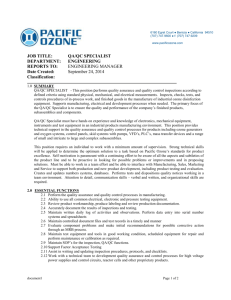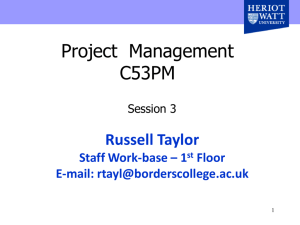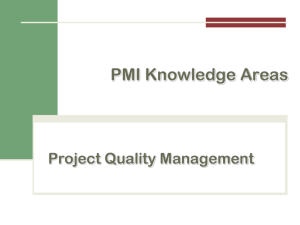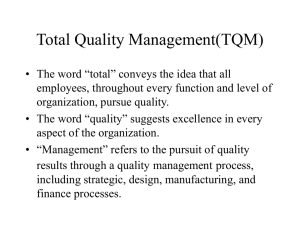Quality Management in Construction Projects L1r
advertisement
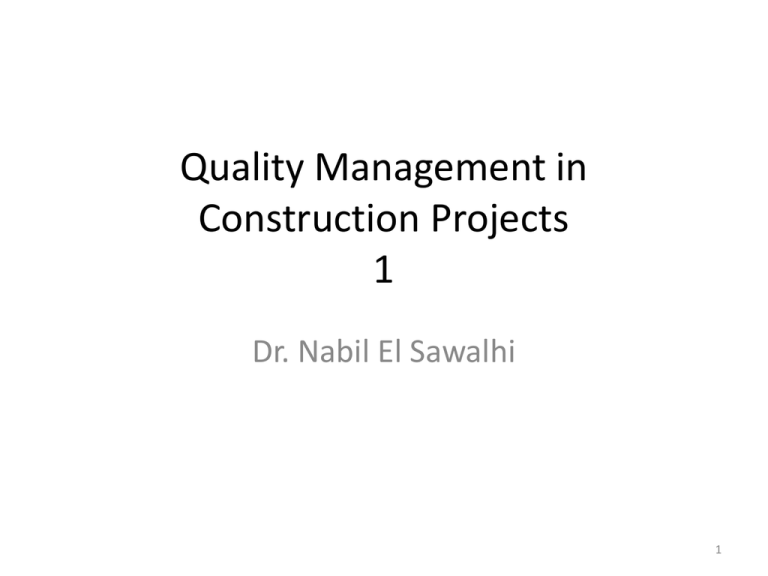
Quality Management in Construction Projects 1 Dr. Nabil El Sawalhi 1 • • • • • • • • Overview of Quality 1.1 Quality Definition 1.2 Quality Inspection 1.3 Quality Control 1.4 Quality Assurance 1.5Quality Engineering 1.6 Quality Management 1.7 Quality Gurus 2 • • • • • • • 1.8 Total Quality Management 1.9 Quality Function Deployment 1.10 Six Sigma 1.11 TRIZ. 1.12 Quality in Use of CAD Software 1.13 Value Methodology 1.14 Integrated Quality Management 3 2. Integrated Quality Management – International Organization for Standardization (ISO) 3.Construction Projects 4.Quality in Construction Projects 5.Operation and Maintenance 6.Facility Management 7.Assessment of Quality 4 history • Quality control was primarily carried out by inspection of goods before sale. • With the advent of the Industrial Revolution marked the beginning of quality control through inclusion of process in quality practices. • Quality concepts moved through different stages such as inspection, quality control, quality assurance, and total quality to reach the quality concept called Total Quality Management (TQM). 5 Quality Development • Prior to World War I • Quality was viewed predominantly as inspection, sorting out the good items from the bad. • Following World War I and up to the early 1950s • Emphasis was still on sorting good items from bad. However, quality control principles were now emerging in the form of: 6 • • • • Statistical and mathematical techniques. Sampling tables. Process control charts. From the early 1950s to the late 1960s, Quality control evolved into quality assurance with its emphasis on problem avoidance rather than problem detection. 7 • Additional quality assurance principles emerged, such as: • The cost of quality • Zero-defect programs • Reliability engineering • Total quality control 8 • Today, emphasis is being placed on strategic quality management, including such topics as • Quality is defined by the customer. • Quality is linked with profitability on both the market and cost sides. • Quality has become a competitive weapon. • Quality is now an integral part of the strategic planning process. • Quality requires an organization wide commitment. 9 • Quality system in its different forms has moved through distinct quality eras such as • 1. Quality inspection • 2. Quality control • 3. Quality assurance • 4. Total quality 10 11 Quality Definition • The American Society for Quality (ASQ) glossary defines quality as: • A subjective term for which, each person has his own definition. • In technical usage, quality can have two meanings: • 1. The characteristics of a product or service that bear on its ability to satisfy stated or implied needs. • 2. A product or service free of deficiencies. 12 • The International Organization for Standardization (ISO, 1994a) defines quality as: • “the totality of characteristics of an entity that bears on its ability to satisfy stated or implied needs.” 13 • Definitions of quality by Gurus: • 1. Philip B. Crosby—Conformance to requirements . • 2. W. Edward Deming—Quality should be designed into both product and the process. • 3. Armand V. Feigenbaum—Best for customer use and selling price. 14 • 4. Kaoru Ishikawa—Quality of the product as well as after-sales services, quality of management, the company itself, and the human being. • 5. Joseph M. Juran—Quality is fitness for use. • 6. John S. Oakland—Quality is meeting customer’s requirements. 15 • A common definition of quality. It is mainly related to the manufacturing, processes, and service industries: • Meeting the customer’s need • Fitness for use • Conforming to requirements 16 Quality in construction • Quality is • The fulfillment of project responsibilities in the delivery of products and services in a manner that meets or exceeds the stated requirements and expectations of the owner, design professional, and constructor. 17 • Responsibilities • refer to the tasks that a participant is expected to perform to accomplish the project activities as specified by contractual agreement and applicable laws and licensing requirements, codes, prevailing industry standards, and regulatory guidelines. 18 • Requirements are what a team member expects or needs to receive during and after his or her participation in a project. 19 Why quality in construction is different • Quality of construction is more difficult to define. • The product is usually not a repetitive unit but a unique piece of work with specific characteristics. • Secondly, the needs to be satisfied include not only those of the client but also the expectations of the community into which the completed building will integrate. 20 Quality in construction • Construction project quality is the fulfillment of the owner’s needs per defined scope of works within a budget and specified schedule to satisfy the owner’s/user’s requirements. 21 Quality Inspection • Inspection is a specific examination, testing, and formal evaluation exercise and overall appraisal of a process, product, or service to ascertain if it conforms to established requirements. • It involves measurements, tests, and gauges applied to certain characteristics in regard to an object or an activity. • The results are usually compared to specified requirements and standards for determining whether the item or activity is in line with the target. • Inspections are usually nondestructive. 22 • Some of the nondestructive methods of inspection are: • Visual • Liquid dyed(colored) penetrate • Magnetic particle • Radiography تصوير اشعاعي • Ultrasonic موجات فوق صوتيه • Eddy current تيار دوام • Acoustic emission انبعاث صوتي • Thermograph المرسام الحراري 23 Inspection accuracy • • • • • Inspection accuracy depends on 1. Level of human error 2. Accuracy of the instruments 3. Completeness of the inspection planning Human errors in inspection are mainly due to – – – – Technique errors Inadvertent(not planned) errors Conscious errors Communication errors 24 • Most construction projects specify that all the contracted works are subject to inspection by the owner/consultant/owner’s representative 25 Quality Control • Quality control as the process employed to consistently meet standards. • The control process involves observing actual performances, comparing it with some standards, and then taking action if observed performance is significantly different from the standard. 26 • Control involves a universal sequence of steps as follows: • 1. Choose the control subject, that is, choose what we intend to regulate. • 2. Establish measurement. • 3 Establish standard of performance, product goal, and process goals. • 4. Measure actual performance. • 5. Compare actual measured performance against standards. • 6. Take action on the difference. 27 Quality Control Tools • The following are the most commonly used quality control tools for a variety of applications to improve the quality process: • 1. Cause-and-effect diagram • 2. Check sheet • 3. Control chart • 4. Data collection • 5. Flow chart 28 • • • • • 6. Histogram 7. Pareto analysis 8. Pie chart 9. Run chart 10. Scatter diagram 29 Cause-and-effect • The cause-and-effect diagram is also called an Ishikawa diagram or fishbone diagram. • It is used to organize and graphically display multiple causes with a particular effect. Figure 1.4 illustrates an example of a cause-andeffect diagram for bad concrete (failure to comply with design concrete strength). 30 31 Check sheet • A check sheet is a structured list, prepared from the collected data, to indicate how often each item occurs. Table 1.2 illustrates a Check sheet for approval record 32 33 Control chart • The control chart is the fundamental tool of statistical process control. • It is a graph used to analyze variation in a process. • By comparing current data to historically determined lines, one can arrive at a conclusion regarding whether the process is stable or is being affected by special cause of variation. • There are many types of control charts. • Each is designed for a specific kind of process or data. 34 • A control chart is employed to distinguish between the existence of a stable pattern of variation and the occurrence of an unstable pattern. • Figure 1.5 illustrates sound level results of an audiovisual system. 35 36 Data collection • • • • • • Data collection objectives are to Identify the problem Report the problem Verify the problem Analyze the problem Correct the problem 37 Flowchart • A flowchart is a pictorial tool that is used for representing a process in sequential order. • Flowcharts can be applied at all stages of the project life cycle. • Figure 1.6 illustrates a flowchart for concrete casting. 38 39 Histogram • The histogram is a pictorial representation of a set of data. • It is created by grouping measurements into cells, and it displays how often the different values occur. • Figure 1.7 illustrates a histogram for manpower for a period of one month. 40 41 Pareto analysis • Pareto analysis is a graphical representation of frequency of occurrence. • Pareto charts are used to identify those factors that have the greatest cumulative effect on the system, and thus, less significant factors can be screened out from the process. • Pareto analysis can be used at various stages in a quality improvement program to determine which step to take next. • Figure 1.8 illustrates a Pareto chart for variation cost. 42 43 Pie chart • The pie chart is a circle divided into wedges to depict proportion of data or information in order to understand how they make up the whole. • The portions of entire circle or pie sum up to 100%. • Figure 1.9 illustrates the contents of construction project cost. 44 45 Run chart • The run chart is a graph plotted by showing measurement (data) against time. • Run charts are used to know the trend or changes in the average and also to determine if the pattern can be attributed to common causes of variation, or if special causes of variation were present. • Figure 1.10 illustrates a run chart for manpower at a site for a particular week. It is similar to the control chart but does not show control limits. 46 47 Scatter diagram • The scatter diagram is a plot of one variable versus another. It is used to identify potential root cause of problems and to evaluate cause and-effect relationship. • Figure 1.11 illustrates a scatter diagram for length versus height of rods. 48 49 Quality Assurance • Is all the planned and systematic activities implemented within the quality system that can be demonstrated to provide confidence a product or service will fulfill requirements for quality 50 • According to ISO 9000 • Quality assurance is those planned and systematic actions necessary to provide adequate confidence that product or service will satisfy given requirements for quality. 51 • Quality Assurance is similar to the concept of the financial audit, which provides assurance of financial integrity by establishing, through “independent” audit, that the plan of accounting is (1) such that, if followed, it will correctly reflect the financial condition of the company, and (2) that it is actually being followed. 52 • QA is focused on planning, documenting and agreeing on a set of guidelines that are necessary to assure quality. • The purpose of QA is to prevent defects from entering into the solution in the first place. • In other words, QA is a pro-active management practice that is used to assure a stated level of quality. 53 Quality assurance covers all activities from • design, • development, • Production/construction, • installation, and • servicing to documentation, and also • includes regulations of the quality of raw materials, assemblies, products, and components; services related to production; and management, production, and inspection processes 54 • Quality assurance in construction projects covers all activities performed by the design team, contractor and quality controller/auditor (supervision staff) to meet owners’ objectives as specified and to ensure that the project/facility is fully functional to the satisfaction of the owners/end users. 55 QUALITY ASSURANCE AND THE CONTRACT • The following are typical of clauses included in Invitations to Tender to specify the obligations of the contractor in respect of quality assurance according to BS5750 Part 2: • The Contractor will develop and operate a formal Quality Assurance System in accordance with BS 5750: Part 2 and to the approval of the Supervising Officer (SO) and shall appoint and name a representative on-site to oversee its implementation. • 2. The Quality Assurance System will cover management organization and procedures for the contract. 56 • 3. In the event of the Contractor being awarded the contract, he will submit within 4 weeks of receiving contract notification a complete version of his proposed Quality Plan to the SO for his approval. • 4. The approved Quality Plan will be considered as forming part of the contract documentation and the Contractor will operate in accordance with its requirements. Any changes to the plan shall be agreed with the SO. 57 SCOPE • BS 5750: Part 2 scope is designed to specify quality system requirements for use ‘where a contract between two parties requires demonstration of a supplier’s capability to control the processes that determine the acceptability of product supplied’. 58 MANAGEMENT • Quality system standards require the establishment and definition of management structures for the assurance of quality. • They stipulate, for example, that responsibilities for attaining quality objectives should be formally assigned; that there should be a management representative who, irrespective of other responsibilities, should have defined authority and responsibility for ensuring that the requirements of the standard are implemented; that systematic management reviews should be instituted, and so on. 59 PURCHASING • BS 5750 confirms the contractor’s responsibility for ensuring that bought-in materials comply with specification and draws attention to the need for clarity in purchasing data. • It also prescribes the right, if specified in the contract, of the purchaser or his representative to inspect at source or upon receipt. 60 CONTROL OF WORK • BS 5750: Part 2 is that work should be carried out under ‘controlled conditions’. • Examples given of ‘controlled conditions’ include documented work instructions and the certification of processes and equipment. • It is also recommended that there should be ‘monitoring’. 61 RECORDS • BS 5750 says that ‘Quality records shall be maintained to demonstrate achievement of the required quality and the effective operation of the quality system’. • Note the two fold purpose of this requirement. Suppliers (contractors) are required to produce records to verify both the quality (i.e. compliance with specification) of the product, and the effectiveness of the system. 62 The quality assurance shortcomings • Its focus is internal. • Specifications are developed by the designers, often with only a vague idea of what customers really want. • The scope of quality assurance is generally limited to those activities under the direct control of the organization; • Important activities such as transportation, storage, installation, and service are typically either ignored or given little attention. 63 • Quality assurance pays little or no attention to the competition’s offerings. • The result is that quality assurance may present a rosy picture, even while quality problems are putting the firm out of business. 64 Quality Engineering • The body of technical knowledge for formulating policy and for analyzing and planning product quality in order to implement and support that quality system which will yield full customer satisfaction at minimum cost 65 Quality Engineering • • • • • • • • It includes: Process capability analysis Quality planning Establishing quality standards Test equipment and gage design Quality troubleshooting Analysis of rejected or returned material Special studies (measurement error, etc.) 66 Techniques used in quality engineering technology 1. Formulating of quality policy • Techniques for identifying the quality objectives and quality policy of a particular company as a foundation for quality analysis and systems implementation. 67 2. Product-quality analysis • Techniques for analyzing include those for isolating and identifying the principal actors that relate to the quality of the product in its served market. 68 69 3. Quality operations planning • Techniques for implementing the quality system emphasize the development in advance of a proposed course of action and methods for accomplishing the desired quality result. • These are the quality planning techniques underlying—and required by—the documentation of key activities of the quality system. 70 Quality Management • It is the application of quality management system in managing a process to achieve maximum customer satisfaction at the lowest overall cost to the organization while continuing to improve the process 71 • The concept of quality management started after World War II, broadening into the development of initiatives that attempt to engage all employees in the systematic effort for quality. • Quality management resulted from the work of the “quality gurus” and their theories. • Extension of quality management concepts gave birth to Total Quality Management (TQM). 72 73 Quality System • is the agreed on, companywide and plant wide operating work structure, documented in effective, integrated technical and managerial procedures, for guiding the coordinated actions of the people, the machines, and the information of the company and plant in the best and most practical ways to assure customer quality satisfaction and economical costs of quality. 74 • Systems engineering • is likely to provide what might be thought of as the fundamental “design technology” of the modern quality engineer. • Systems management • is likely to become a fundamental management guide for the quality manager. 75 • Systems economics • particularly with respect to formalized total quality cost accounting, is likely to provide a major business guide-control point for the general manager. 76 Generic term of quality management • 1. The management of quality is crucial to company survival and merits the personal attention and commitment of top management. • 2. The primary responsibility for quality must lie with those doing the work. Control by inspection is of limited value. • 3. To enable a production department to accept responsibility for quality, management must establish systems for the control and verification of work, and must educate and indoctrinate the work force in their application. • 4. The costs of education and training for quality, and other costs which might be incurred, will be repaid many times over by greater output, less waste, a better quality product and higher profits. 77


